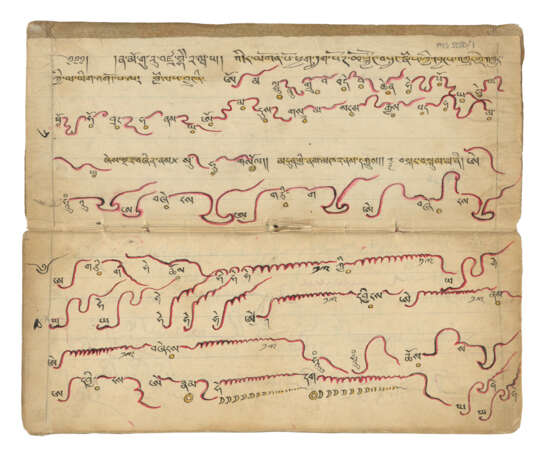ID 1053272
Lot 158 | Yang Chants with Tibetan dbyangs-yig notation
Estimate value
£ 3 000 – 5 000
Two manuscripts of Yang Chants, in Tibetan, on paper [Tibet, 19th century]
Yang Chants with Tibetan Yang-Yig graphic music notation.
c.223 x 90mm, two manuscripts: the first with 22 leaves, 4 lines in Tibetan dbu script with Tibetan dbyangs-yig (or Yang-Yig) graphic notation in red and yellow; the second with 12 leaves and 6-7 lines in Tibetan dbu script with similar notation in red (the second manuscript with a little marginal staining, else both in excellent condition). The first manuscript with a binding of 19th-century silk sewn on 3 cords, with a red and black diagram on upper cover; the second manuscript unbound, sewn on 5 cords.
Provenance:
(1) Sam Fogg, London, acquired in 2005 by:
(2) Schøyen Collection, MS 5280.
Text and Music:
The manuscript belongs to the ‘Yang’ tradition, the most highly involved and regarded chant tradition in Tibetan music, and the only one to rely on a system of notation (Yang-Yig). The chant consists of smoothly effected rises and falls in intonation, which are represented by complex curved lines. The notation also frequently contains detailed instructions concerning in what spirit the music should be sung (e.g. flowing like a river, light like bird song) and the smallest modifications to be made to the voice in the utterance of a vowel. On the whole, Yang chants are sung at an extremely low pitch and at a lingering and subtly changing pace, allowing full expression of the chanted text. Such texts as these would have been used as a mnemonic device by the Master of Chant in a monastery in leading the monastery in the performance of a chant. The type of graphic notation of the melody line goes back to the 6th century. It records neither the rhythmic pattern nor duration of the notes. Similar manuscripts can be seen on the Buddhist Digital Resource Centre (BDRC).
| Place of origin: | Tibet |
|---|---|
| Auction house category: | Medieval & renaissance manuscripts |
| Place of origin: | Tibet |
|---|---|
| Auction house category: | Medieval & renaissance manuscripts |
| Address of auction |
CHRISTIE'S 8 King Street, St. James's SW1Y 6QT London United Kingdom | ||||||
|---|---|---|---|---|---|---|---|
| Preview |
| ||||||
| Phone | +44 (0)20 7839 9060 | ||||||
| Buyer Premium | see on Website | ||||||
| Conditions of purchase | Conditions of purchase |






